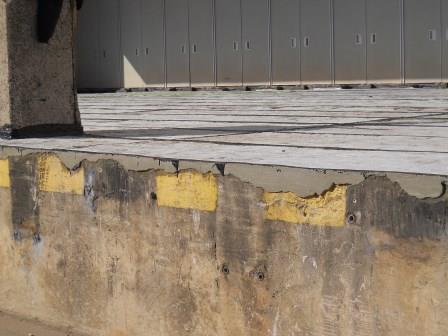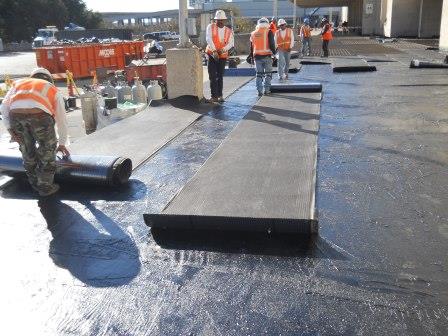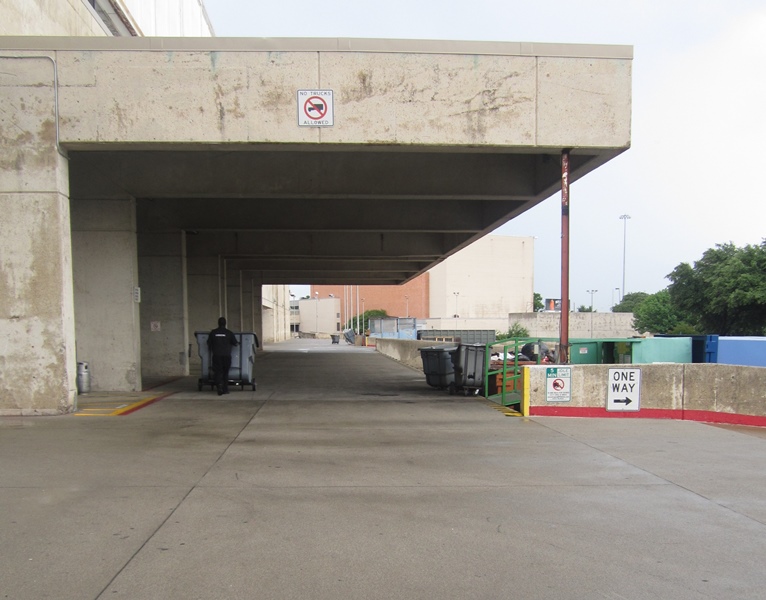As a part of the renovation of the Kay Bailey Hutchinson Convention Center in the heart of Dallas, Texas, Chamberlin Roofing & Waterproofing was called in to assess and rehabilitate many areas of the convention center campus. According to Ryan Grigsby, senior project manager with Chamberlin, the convention center — formerly called the Dallas Convention Center — was built in 1957, and some areas in need of improvement had not been renovated since the original construction.
“Remedial waterproofing to stop persistent leaks and expanding the storm drain system were the main concerns for the job as a whole,” said Grigsby. The Chamberlin team was tasked with re-waterproofing the loading dock, A/B Hall, The Black Academy of Arts and Letters Building, which included a 40-foot (12 m) deep excavation, the Arena Building, and Ceremonial Drive.
Loading Dock Low-Down
The 1,800-square-foot (167 m²) loading dock of the convention center is situated above an underground parking structure, and as Grigsby pointed out, the concrete substrate had seen better days. “There were water infiltration issues and the concrete was cracked and spalled. The only way to solve the problem was to demo the topping slab, take off the waterproofing membrane, and start over,” he said.
Jerry Elliot, general superintendent on the job, agreed. “We hired TNC Cutters to come in and do the demo work. They jack-hammered the topping slab, so that we could remove the old asphalt membrane between the topping slab and structural deck,” explained Elliott.
Once the demolition work was completed, the team removed the membrane using hand-held Dewalt grinders. Then, with the old and failing waterproofing membrane out of the picture, the Chamberlin team repaired areas of the structural deck that were damaged. “We used a repair mortar to patch those areas. For this particular job, we used Euclid’s VERSASPEED LS, a versatile, single-component, rapid-strength-gaining repair mortar for horizontal and form-and-pour repair projects. VERSASPEED LS is a low-shrinkage, high-early-strength material that is easy to use for fast turn-around projects,” said Grigsby.
At this point it was time for the 10-member Chamberlin crew to lay down the hot fluid rubberized Tremco 6100 waterproofing system. “The Tremco product comes in boxes that are basically chunks of asphalt. We put these chunks into a kettle that is heated to approximately 425–450° F [218–232° C]. The asphalt is melted down and placed in steel buckets and poured onto the slab. We used squeegees to lay down the correct thickness of 90 mils [2,286 microns],” said Grigsby.
 The crew then laid down Tremo’s geotextile reinforcing fabric and applied another 125-mil (3,175 microns) layer of the hot fluid rubberized system. According to Elliott, the cure time for the Tremco 6100 is relatively quick: they were ready to put down Tremco’s TREMDrain 2000, a multi-composite drainage and protection board, the next day.
The crew then laid down Tremo’s geotextile reinforcing fabric and applied another 125-mil (3,175 microns) layer of the hot fluid rubberized system. According to Elliott, the cure time for the Tremco 6100 is relatively quick: they were ready to put down Tremco’s TREMDrain 2000, a multi-composite drainage and protection board, the next day.
With the new waterproofing system in place, Chamberlin brought in Pavement Services to put in the reinforcing steel and pour the new topping slab. It was now time for the application of Sika’s Sikadur 22 Lo Mod Broadcast System. “One of the reasons why this coating system was a great choice for this job is because it can be applied 14 days after new concrete is poured. With the tight schedule surrounding all aspects of this job, this was a huge help in completing the job on time,” said Grigsby.
Sikadur 22 Lo-Mod is a two-component, 100 percent solids, moisture-tolerant, epoxy resin binder. “Lo-Mod” means low modulus, a characteristic of the coating system that allows for movement of the substrate. (High modulus coatings tend to be stiffer and allow for less movement of the substrate.) This property makes it a great choice for the concrete loading dock, as the concrete will expand and contract based on the ambient temperature.
The crew poured the Sikadur 22 Lo-Mod onto the substrate and used squeegees to achieve the proper thickness of 25 mils (635 microns). “We then flood coated the substrate with #4 flint rock,” said Elliott. The excess aggregate was swept off and another 25 mils (635 microns) of the coating system was applied. The final piece of the puzzle was to install new dock bumpers and have Pavement Services come back to stripe the loading dock.
Half and Half
The loading dock was in use throughout construction for everything that took place at the convention center, so the scheduling of the waterproofing work was carefully thought out and planned. Multiple trades had to be considered, as did  the numerous events held at the convention center at any given time. The events affected accessibility of the loading dock, imposed noise-level restrictions, and caused frequent starts and stops.
the numerous events held at the convention center at any given time. The events affected accessibility of the loading dock, imposed noise-level restrictions, and caused frequent starts and stops.
When it came to scheduling the work on the loading dock, managers decided to divide the project into two phases. “To accommodate for the heavy usage of the loading dock area, the loading dock was completed in two phases. The entire scope of the project — concrete demolition, removal of the old waterproofing, repair work, and the application of the hot-fluid waterproofing and the epoxy deck coating — was completed on one half of the loading dock, leaving the other half available for use,” explained Grigsby. The first phase of the loading dock took place from November through December 2012 and phase two ran from April 2013 to May 2013. Chamberlin, the architect, and the owner met every two weeks to keep the project moving forward. According to Grigsby, communication was key for the entire project team to deliver this project efficiently and on time.
The Safety Factor
All required personal protective equipment (PPE) was used on the job. The crew wore full pants, boots, safety vests, leather gloves, hard hats, and safety glasses. “For the hot fluid waterproofing portion of the job, the kettle operator also wore a face shield and an apron, and the area around the kettle was barricaded off and inspected daily,” said Grigsby.
In addition, Chamberlin safety professionals made frequent jobsite inspections throughout the project utilizing an electronic safety auditing system: SafetyNet by Predictive Solutions. During these audits, the safety professionals observed and interviewed Chamberlin employees and subcontractors. The safety professionals recorded their observations electronically through the SafetyNet app, and these observations were then synced to the Predictive Solutions system. Chamberlin’s project management team met weekly with the safety professionals to review the results from the safety audits. According to Grigsby, at these meetings any needed adjustments in safety procedures were evaluated. “I am thrilled to report that the entire project was completed with zero safety incidents,” stated Grigsby.
A Great Team
Both Grigsby and Elliott are quick to compliment the entire team who worked on the job, from the applicators to the architect and the City of Dallas Public Works. “It was really a team effort, especially since we were working in a facility where thousands of people come through every day: visitors, staff, and other trades. It was challenging, but working together, we finished the job on time and with very few issues,” said Elliott.
